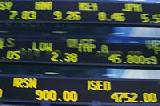
 |
|
| Financial Terms | |
| Moving-averages chart |
|
Information about financial, finance, business, accounting, payroll, inventory, investment, money, inventory control, stock trading, financial advisor, tax advisor, credit.
Main Page: payroll, investment, tax advisor, business, money, inventory control, stock trading, credit, |
Definition of Moving-averages chart
Moving-averages chartA financial chart that plots leading and lagging
Related Terms:ChartistsRelated: technical analysts. Corporate charterA legal document creating a corporation. Moving averageUsed in charts and technical analysis, the average of security or commodity prices Point and figure chartA price-only chart that takes into account only whole integer changes in price, i.e., a Simple moving averageThe mean, calculated at any time over a past period of fixed length. break-even charta graph that depicts the relationships among revenues, variable costs, fixed costs, and profits (or losses) control charta graphical presentation of the results of a  organization charta depiction of the functions, divisions, value charta visual representation indicating the valueadded Bollinger band chartA financial chart that plots actual asset data along Candlestick chartA financial chart usually used to plot the high, low, open, High-low-close chartA financial chart usually used to plot the high, low, Moving averageA price average that is adjusted by adding other Point and figure chartA financial chart usually used to plot asset price data. Chart of accountsA listing of all accounts used in the general ledger, usually sorted in Moving average inventory methodAn inventory costing methodology that calls for the re-calculation of the average cost of all parts in stock after every purchase. Slow-moving itemAn inventory item having a slower rate of turnover than the Related to : financial, finance, business, accounting, payroll, inventory, investment, money, inventory control, stock trading, financial advisor, tax advisor, credit. |